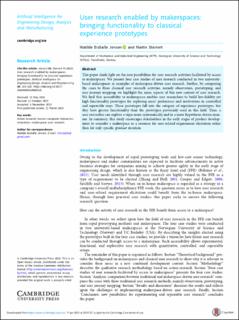| dc.contributor.author | Jensen, Matilde Bisballe | |
| dc.contributor.author | Steinert, Martin | |
| dc.date.accessioned | 2021-01-18T12:04:59Z | |
| dc.date.available | 2021-01-18T12:04:59Z | |
| dc.date.created | 2021-01-11T10:56:41Z | |
| dc.date.issued | 2020 | |
| dc.identifier.citation | Artificial intelligence for engineering design, analysis and manufacturing. 2020, 34 (3), 315-326. | en_US |
| dc.identifier.issn | 0890-0604 | |
| dc.identifier.uri | https://hdl.handle.net/11250/2723467 | |
| dc.description.abstract | This paper sheds light on the new possibilities for user research activities facilitated by access to makerspaces. We present four case studies of user research conducted in two university-based makerspaces as examples of makerspace-driven user research. Further, by comparing the cases to three classical user research activities, namely observation, prototyping, and user journey mapping, we highlight the main aspects of this new context of user research. We find that accessibility to makerspaces enables user researchers to build low-fidelity yet high-functionality prototypes for exploring users’ preferences and motivations in controlled and repeatable ways. These prototypes fall into the category of experience prototypes, but they have greater functionality than the prototypes previously used in this field. Thus, a user researcher can explore a topic more systematically and in a more hypothesis-driven manner. In summary, this study encourages stakeholders in the early stages of product development to consider a makerspace as a resource for user-related requirement elicitation rather than for only specific product iteration. | en_US |
| dc.language.iso | eng | en_US |
| dc.publisher | Cambridge University Press | en_US |
| dc.rights | Navngivelse 4.0 Internasjonal | * |
| dc.rights.uri | http://creativecommons.org/licenses/by/4.0/deed.no | * |
| dc.title | User research enabled by makerspaces: bringing functionality to classical experience prototypes | en_US |
| dc.type | Peer reviewed | en_US |
| dc.type | Journal article | en_US |
| dc.description.version | publishedVersion | en_US |
| dc.source.pagenumber | 315-326 | en_US |
| dc.source.volume | 34 | en_US |
| dc.source.journal | Artificial intelligence for engineering design, analysis and manufacturing | en_US |
| dc.source.issue | 3 | en_US |
| dc.identifier.doi | https://doi.org/10.1017/S089006042000013X | |
| dc.identifier.cristin | 1868717 | |
| dc.description.localcode | © Cambridge University Press 2020. This is an Open Access article, distributed under the terms of the Creative Commons Attribution licence (http://creativecommons.org/licenses/ by/4.0/), which permits unrestricted re-use, distribution, and reproduction in any medium, provided the original work is properly cited. | en_US |
| cristin.ispublished | true | |
| cristin.fulltext | original | |
| cristin.qualitycode | 1 | |

